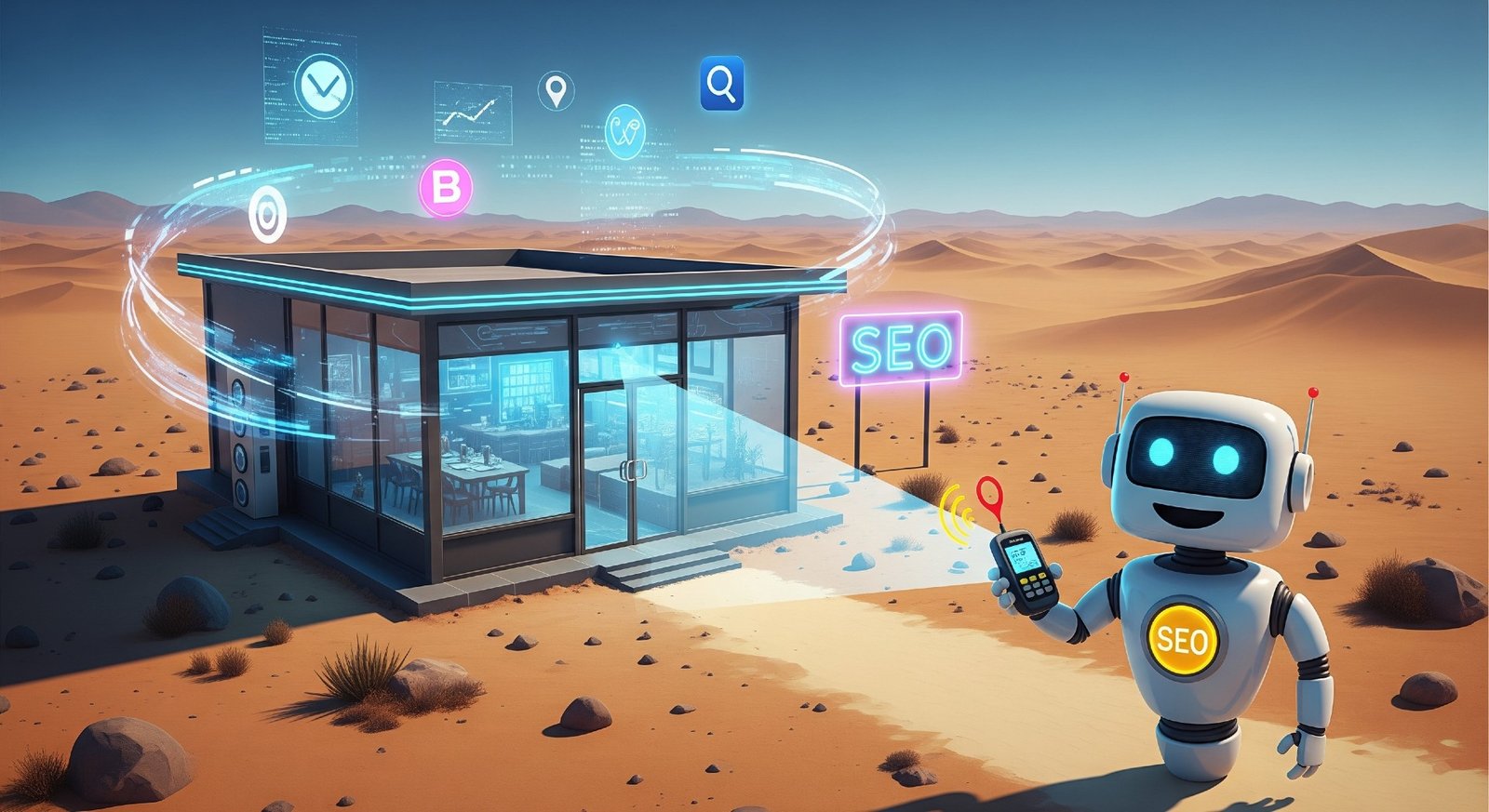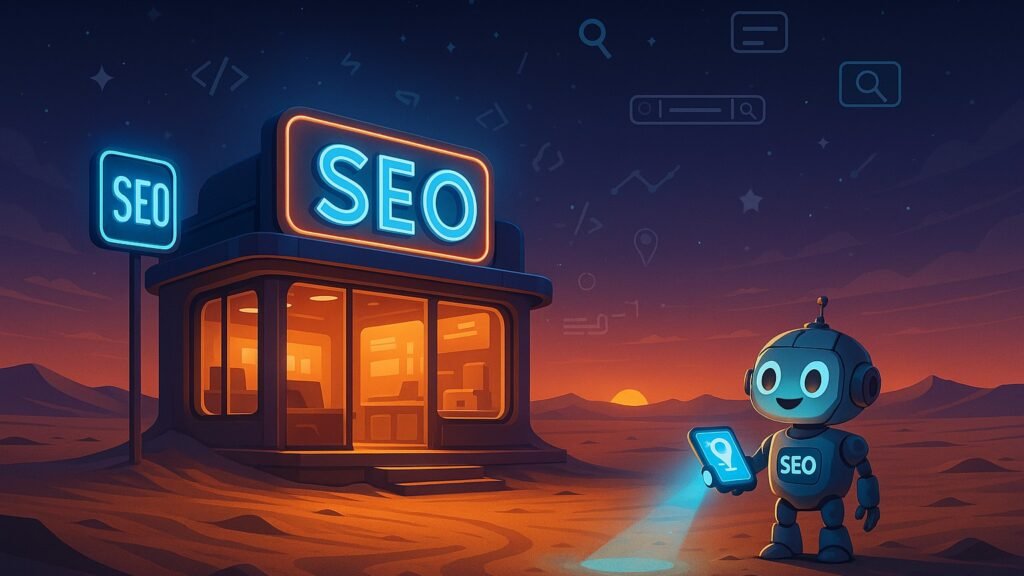Imagine the grand opening of your dream store. It’s magnificent, stocked with the most incredible products, boasts jaw-dropping prices, and even features a friendly robot named Dave who greets every visitor with freshly baked cookies. Sounds perfect, right? Well, there’s just one tiny, rather inconvenient hitch: you’ve built this masterpiece in the middle of a sprawling desert. No roads. Not a single sign. Not even a thirsty camel in sight to stumble upon your digital oasis.
That is your website without the magic of SEO.
Search Engine Optimization in 2025 is not a dark art (despite the mysterious acronyms). It’s the GPS, the neon sign, and the friendly local guide that bring customers to your digital doorstep. And just like that, imaginary robot Dave, good SEO works around the clock without asking for a lunch break.
Let’s peel back the layers and transform your invisible corner of the internet into the most popular hotspot online. Buckle up. It’s going to be a long, funny, and deeply insightful ride.
Chapter 1: What Is SEO and Why Should You Care?
Imagine your shop tucked away in a quiet alley. SEO is how you get a glowing sign above the door, a banner in the main square, and a guide handing out flyers saying, “This way to the best store in town!” It’s the practice of making your online presence visible, clear, and appealing so that when people search, you’re right there where they need you—easy to find, impossible to ignore.
The Real Reason SEO Matters
Statistics show that a staggering 96.55% of users never click past the first page of search results. That makes page two the digital equivalent of Mordor—a shadowy place where great content quietly fades away. No matter how valuable or brilliant your page is, if it’s buried past that front page, it’s as good as invisible. That statistic isn’t just trivia; it’s a blunt reality check.
Users trust Google’s first page like it’s the front row at a concert. If you’re not there, you’re background noise. The top 10 is where visibility, trust, and traffic collide. That’s where your website starts working for you.
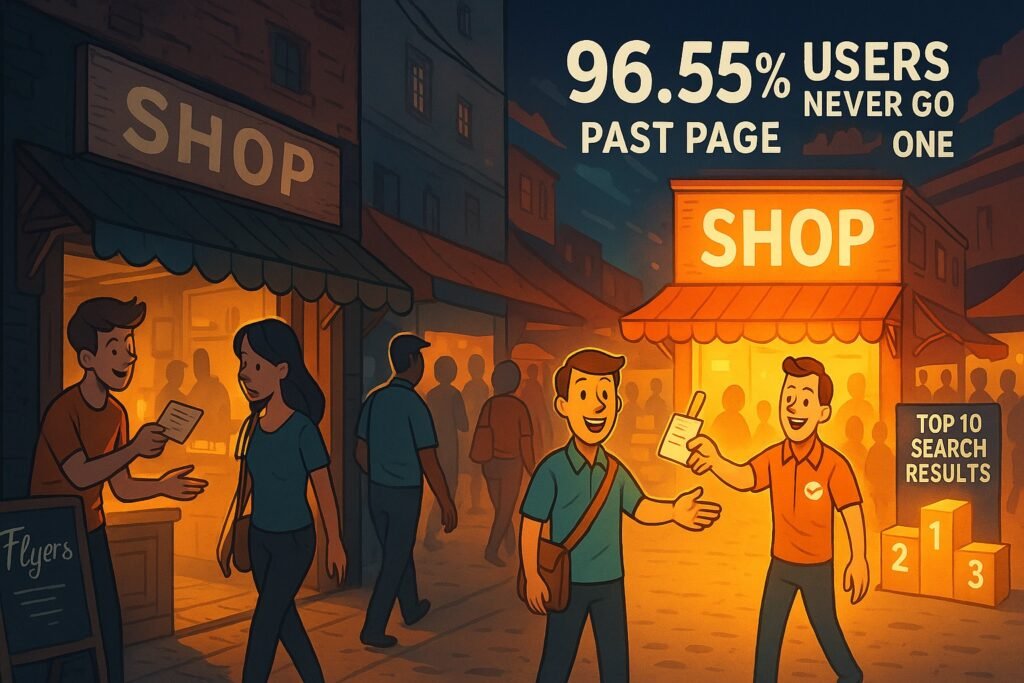
Your mission? Claim your rightful spot in that golden lineup and keep it polished, optimized, and ready to perform. 🚀
Without SEO:
- Your amazing content is like a Nobel Prize-winning book placed on a dusty back shelf at a garage sale.
- Your brand is invisible.
- Your competitors are dancing on page one without you.
With SEO:
- You’re where people are searching.
- You’re relevant, visible, and clickable.
- You may even get fan mail (okay, maybe not… but you’ll get traffic).
Chapter 2: The SEO Universe
Back in the early days, SEO was like tossing breadcrumbs across the web and hoping Google would follow. It was all about stuffing keywords wherever they’d fit, like cramming sale tags on every item in your shop window. But times have changed.
Now, SEO is a sophisticated, fully staffed marketplace strategy, with each specialized area handling a distinct part of your digital storefront. These diverse facets of SEO work in seamless coordination, like a perfectly synchronized team, elevating your shop into the blinding spotlight of organic search, ensuring it shines brightly, competes fiercely, and stands out where it truly matters.
So, what are the esteemed members of this “SEO League”? Well, it’s quite the formidable lineup:
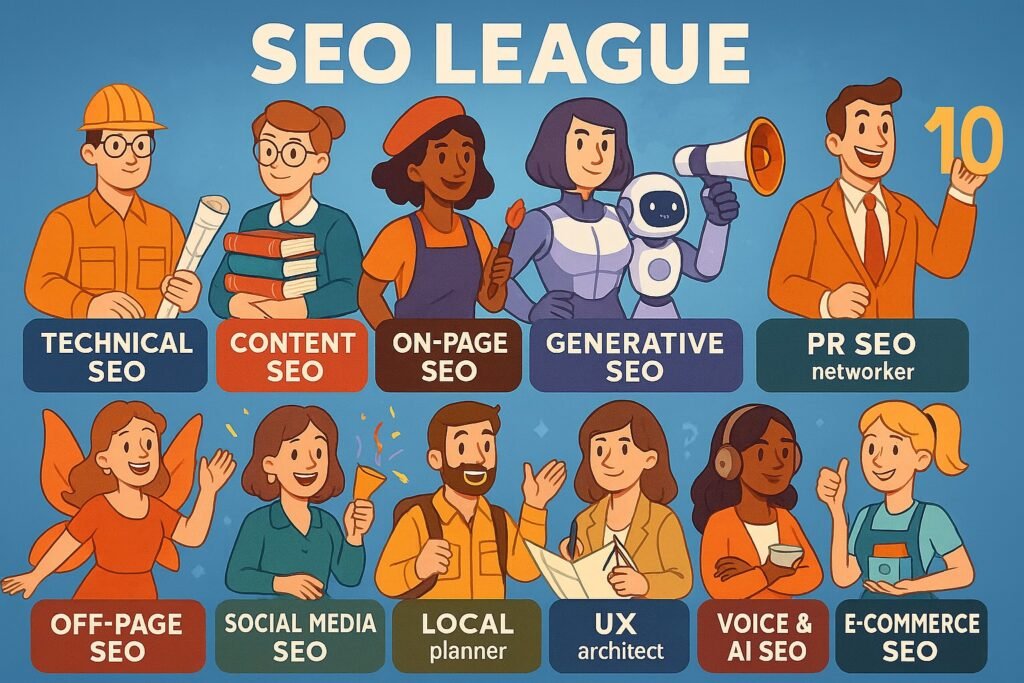
The SEO League Includes:
- Technical SEO: The silent engineer. Builds the roads and tunnels for search bots.
- Content SEO: The charming librarian. Writes beautiful, helpful, optimized prose.
- On-Page SEO: The visual stylist. Make sure each page is easy on the eyes and speaks Google’s language.
- Generative SEO: The futuristic storyteller. Craft content that AI wants to read, share, and select.
- Voice & AI SEO: The interpreter for Siri, Alexa, and their AI cousins.
- E-commerce SEO: The product placement genius and commercial page hierarchy.
- PR SEO: The charismatic networker. Connects your content to journalists, influencers, and digital media for backlinks and buzz.
- Off-Page SEO: The social butterfly. Builds your reputation by getting other trusted sites to talk about you.
- Social Media SEO: The digital party planner. Ensures your content gets shared, liked, and engaged with across platforms to boost visibility and send positive signals back to search engines.
- Local SEO: The friendly neighborhood guide.
- UX SEO: The experience architect, focusing on making your site a joy to navigate, because a happy user is a user who sticks around and converts.
And yes, there’s even Casino SEO and Podcast SEO because why not?
The complexity of modern SEO is truly multifaceted. It’s no longer a small, simple optimization universe. Every type of SEO requires a different approach and specific expertise. Local SEO, for instance, helps local businesses appear prominently in map packs and local searches. Technical SEO meticulously improves the site’s overall health. Content SEO focuses on writing and structuring meaningful pages, while E-commerce SEO enhances product visibility in complex online stores. Voice & AI SEO ensures your answers are precisely selected by digital assistants.
Maybe all roads lead to Rome, but in our case, they lead to your thriving marketplace. This digital market has numerous paths leading to it—Local, Technical, Content, Voice & Chat AI. Therefore, you simply must construct pathways on each of them, so that anyone seeking you can find you, regardless of their starting point.
Click-Through Statistics: The Battle for the Top Spot
Every single digital campaign you run has an impact on your SEO. Advertising campaigns, for example, are excellent for introducing your brand to new users, and subsequently, for boosting your SEO, especially if your website is already in excellent shape. Conversely, SEO profoundly affects everything related to your business, from advertising effectiveness to voice AI responses, and even, delightfully, to your in-store sales.
Let’s return to our bustling marketplace. Your store is now proudly located in the main square, but so are many others. As you observe the foot traffic, a clear pattern emerges: the vast majority of shoppers instinctively gravitate towards the first three stalls they see. To truly thrive, your shop must claim one of those coveted top spots where pedestrian traffic is relentless and curiosity is at its absolute peak.
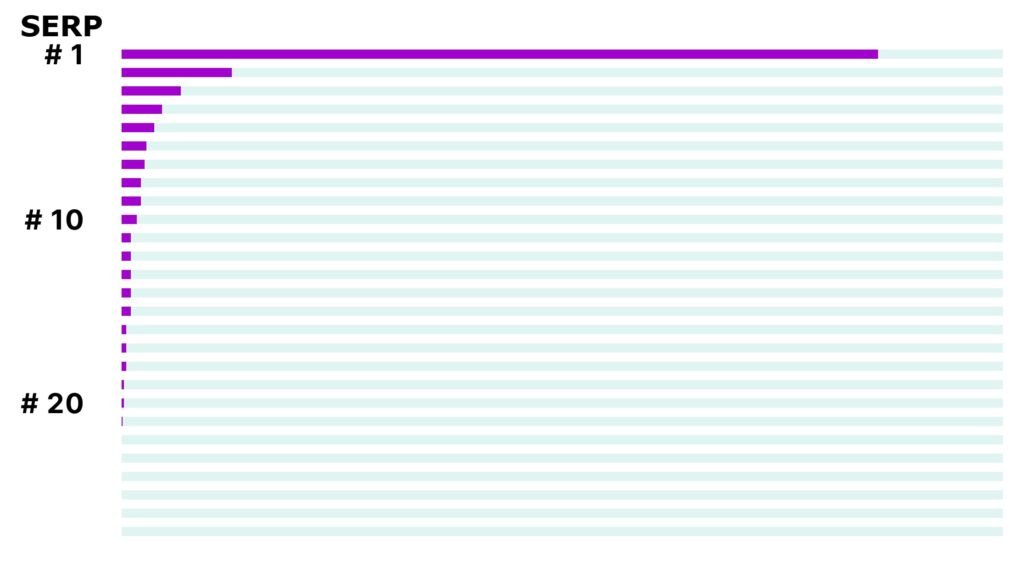
Consider these compelling statistics: the top 3 organic positions capture approximately 68% of all clicks on Google. Securing your content in these highly desired positions is your ultimate objective—it’s your direct pathway to unwavering relevance, undeniable authority, and commercial triumph. While some users may click directly on paid results, others harbor a healthy skepticism towards paid ads, believing any company can simply buy its way to the top. Therefore, these discerning users gravitate towards organic results. This explains why a mere 6% of users click on the top ads.
However, imagine the sheer power of having your website appear in both the paid and organic positions! This dual presence significantly bolsters user trust, subtly conveying that your client’s firm not only boasts a high-quality website but also possesses the considerable scale to run effective paid campaigns. It’s the digital equivalent of having your cake and eating it too, with a side of extra sprinkles! 🍰
Chapter 3: Don’t Write for Robots, Write for People
Yes, Google’s algorithm matters. But people matter more. In 2024, Google fused its “Helpful Content” system into its core. Translation? If your content isn’t helpful, unique, or human-friendly, Google gives it the digital cold shoulder.
The seismic event of the past year was the March 2024 Core Update, a multi-system overhaul that integrated the Helpful Content system directly into its core ranking signals. This update, combined with new and aggressive spam policies, has sent a clear message: low-quality, unoriginal, and user-unfriendly content will be actively demoted.

Offer Human Expertise (even if you use AI to write)
- Use natural language (imagine explaining it to your grandma).
- Answer real questions (Google loves FAQs).
- Don’t just answer with a simple “Yes.” Say, “Yes, …” and expand the answer into a complete and informative sentence or paragraph that includes a subject and verb. This ensures clarity, reinforces credibility, and helps both users and search engines better understand the value of your response. Grammar still matters.
“Google only loves you when everyone else loves you first.” — Wendy Piersall
When your customers are truly happy, they become your most ardent advocates, eagerly spreading the word about your amazing store. Every positive review or mention amplifies your reach, drawing in more people—and Google, in its infinite wisdom, takes notice, beginning to recommend you with greater fervor. Google doesn’t simply adore your brand because you possess a beautifully designed website. You must earn the trust and engagement of your users through genuine interaction.
This means providing a high-quality, comprehensive, relevant, clear, well-structured, easy-to-understand, fast, impactful, and exquisitely designed website. However, even the most perfect website can remain frustratingly invisible if no one ever sees it. You must actively promote it—through PPC campaigns, strategic backlink building, robust social media promotion, and impactful mentions from influential figures—to ensure users discover, explore, and ultimately convert.
Once a sufficient number of users interact with your site and generate strong engagement signals—think lengthy sessions, repeated visits, and joyful conversions—Google will unequivocally take notice. Based on these key performance indicators (KPIs), Google deduces that users genuinely adore your site and begins to rank it higher in search results.
Professional Tip: Google’s algorithm increasingly relies on behavioral metrics such as bounce rate, click-through rate (CTR), dwell time, and conversion events as indirect yet powerful signals of value. So, keep your users happy, and Google will follow suit!

Key Takeaways from the Latest Google Algorithm Updates:
- The Helpful Content System is King: No longer a separate signal, the principles of helpful, reliable, and people-first content are now at the very heart of Google’s ranking algorithm. The aim is to reward content created for humans, not for search engine crawlers.
- E-E-A-T is Non-Negotiable: The concept of Experience, Expertise, Authoritativeness, and Trustworthiness (E-E-A-T) has been heavily reinforced. Demonstrating firsthand experience and deep knowledge is now crucial, especially for “Your Money or Your Life” (YMYL) topics.
- New Spam Policies in Play: Google is cracking down hard on manipulative tactics with three new spam policies:
- Scaled Content Abuse: Mass-producing content with little to no value, whether through AI or human efforts, is now considered spam.
- Expired Domain Abuse: Purchasing and repurposing expired domains to manipulate rankings is a punishable offense.
- Site Reputation Abuse: Allowing third-party content to be published on a reputable site without close oversight (often called “parasite SEO”) is now policed.
Experiments Reveal What Truly Matters
In the wake of these updates, SEO experts globally have been conducting extensive tests to understand the new rules of the game. A study by Amsive on the impact of the Helpful Content Update provides a deep dive into affected site categories:
Content: Beyond Keywords to True Value
- Depth and Originality Trump All: Superficial, rehashed content is being penalized. Successful content provides unique insights, comprehensive information, and a fresh perspective. Case studies have shown that simply updating the date on old content is no longer effective; substantial revisions and additions of new information are necessary.
- First-Hand Experience is a Differentiator: Content that demonstrates the author has personally used a product, visited a place, or has direct experience with the topic is being rewarded. This can be showcased through original photos, personal anecdotes, and detailed, nuanced descriptions.
- AI Content: A Double-Edged Sword: While Google doesn’t penalize AI-generated content outright, low-quality, unedited AI content that lacks originality and E-E-A-T is a primary target of the recent updates. Successful use of AI in content creation involves using it as a tool to assist human writers, who then add their expertise, experience, and unique voice.
User Experience (UX) and Site Architecture
Neil Patel’s analysis of the March 2024 update offers actionable advice on recovery:
- Clean and Clear is the New Standard: Websites with intrusive pop-ups, excessive ads, and a confusing layout have been negatively impacted. A smooth, intuitive user experience is a significant ranking factor.
- Site-Wide Quality Matters: The Helpful Content system applies a site-wide signal. This means that a significant amount of unhelpful content on one part of your site can negatively impact the rankings of your entire domain. SEO experts recommend a “content pruning” approach, where low-performing, unhelpful pages are either significantly improved or removed.
- Internal Linking for Topical Authority: Strategic internal linking helps Google understand the topical authority of your website. Linking from your high-authority pages to relevant, newer content can pass on ranking power and help those pages get indexed and ranked faster.
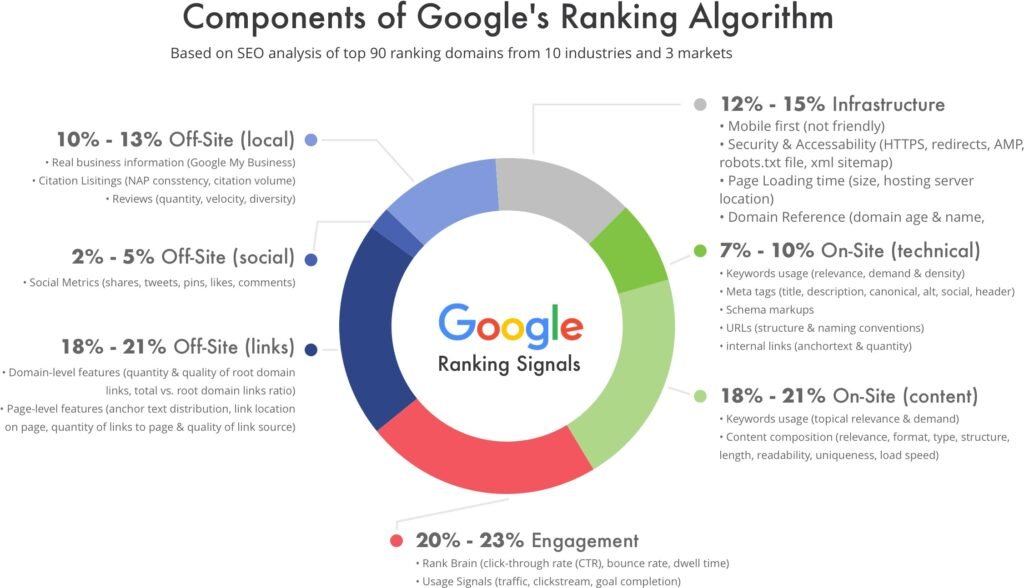
The Top 10 Ranking Factors in the New Era of Search
Based on the latest algorithm updates and expert analysis, here are the top 10 most important ranking factors for organic search, AI search, and voice search.
Top 10 Most Important Factors for Organic Google Search
- Helpful, Reliable, People-First Content: This is the undisputed number one factor. Your content must be original, accurate, comprehensive, and provide real value to the user.
- E-E-A-T (Experience, Expertise, Authoritativeness, Trustworthiness): Clearly demonstrate your credentials, cite your sources, and showcase your experience.
- Topical Authority: Cover a specific niche in-depth to establish your website as a leading resource.
- High-Quality Backlinks: Links from reputable, relevant websites remain a powerful signal of trust and authority.
- User Experience (UX): A fast, mobile-friendly website with intuitive navigation and minimal intrusive elements. This includes Core Web Vitals.
- Search Intent Alignment: Your content must directly address the underlying reason for a user’s search query.
- Keyword Optimization (in Context): While exact-match keywords are less important, using relevant keywords and phrases naturally within high-quality content is still crucial.
- Site Security (HTTPS): A secure website is a baseline requirement for trust.
- Freshness and Regular Updates: Keeping your content up-to-date with the latest information is important for many queries.
- Site-Wide Health: A clean site architecture, free of technical issues and low-quality pages.
Top 10 Most Important Factors for AI Search (e.g., Google’s SGE – Search Generative Experience)
AI-powered search results, like Google’s Search Generative Experience (SGE), synthesize information from multiple sources to provide a direct answer. The ranking factors are evolving, but here’s what early analysis suggests:
- Clear and Concise Factual Accuracy: AI models need to pull accurate, unambiguous information. Content that is well-structured with clear headings and factual statements is more likely to be featured.
- In-Depth, Comprehensive Content: SGE aims to provide a complete answer. Pages that cover a topic exhaustively are valuable sources.
- Strong E-E-A-T Signals: AI will likely rely heavily on established trust signals to ensure the information it presents is reliable.
- Data and Statistics: Content rich with data, statistics, and sourced information is easily digestible for AI and adds credibility.
- FAQ and Q&A Formats: Structuring content to directly answer common questions makes it easy for AI to extract and present information.
- Schema Markup: Structured data helps AI understand the context of your content more effectively.
- Authoritative Sourcing: Citing reputable sources within your content can increase its likelihood of being used in an AI-generated response.
- Positive User Engagement Signals: While indirect, it’s believed that content that is popular and well-regarded by users will be favored by AI.
- Presence in “People Also Ask” Sections: Content that already ranks in these sections has proven its ability to answer specific user questions.
- Simple Language and Clear Syntax: Complex prose can be harder for AI to parse and synthesize accurately.
Top 10 Most Important Factors for Voice Search
Voice search queries are typically conversational and demand immediate, concise answers. The ranking factors reflect this need for speed and clarity.
- Concise and Direct Answers: The ability to provide a brief, accurate answer to a specific question is paramount.
- Featured Snippet Optimization: Voice assistants often read out the featured snippet. Ranking in “position zero” is a primary goal for voice search SEO.
- Conversational Language: Content written in a natural, conversational tone that mirrors how people speak is more likely to be selected.
- FAQ-Style Content: Pages that are structured around questions and answers are a goldmine for voice search.
- Local SEO Optimization: A significant portion of voice searches are for local information (“near me” searches). A well-optimized Google Business Profile is essential.
- Page Speed: Voice search users expect immediate answers. A fast-loading website is crucial.
- Mobile-Friendliness: Voice searches are predominantly performed on mobile devices.
- Structured Data (Schema Markup): Schema helps search engines understand the specifics of your content, making it easier to pull for voice queries.
- High Domain Authority: In the absence of other strong signals, voice assistants may default to trusted, authoritative domains.
- Long-Tail Keyword Strategy: Voice queries are often longer and more specific than typed searches. Targeting these long-tail keywords is key.
By understanding and adapting to these evolving ranking factors, you can position your website for success in the dynamic and increasingly intelligent world of search. The common thread across all forms of search remains the same: a relentless commitment to providing high-quality, user-centric content.
Chapter 4: UX – Because No One Likes Getting Lost in a Maze
Think of your website’s architecture as the blueprint of your physical store. A well-structured site is like a perfectly laid-out shop floor, guiding Google and your users effortlessly to the content they seek.
Always think in terms of clear categories and strategic internal links—these are the aisles and helpful signs that make navigation a breeze.
A site without a clear hierarchy is like a city with streets that lead nowhere, that have one-way traffic, and then dead ends. Think of your store as a well-organized grid. Every product is just a few steps away. No dead ends, no confusion—just easy access to everything. Google and users must easily find essential pages.
The golden rule is: a maximum of 3 clicks to reach the destination (i.e., the page you’re looking for), no matter where you are on the site. Think of your website as a tree: the trunk is your homepage, the branches are your main categories with possible sub-branches (sub-categories), and the leaves are your products. This logical structure improves usability and helps Google understand the semantic relationships between your content.
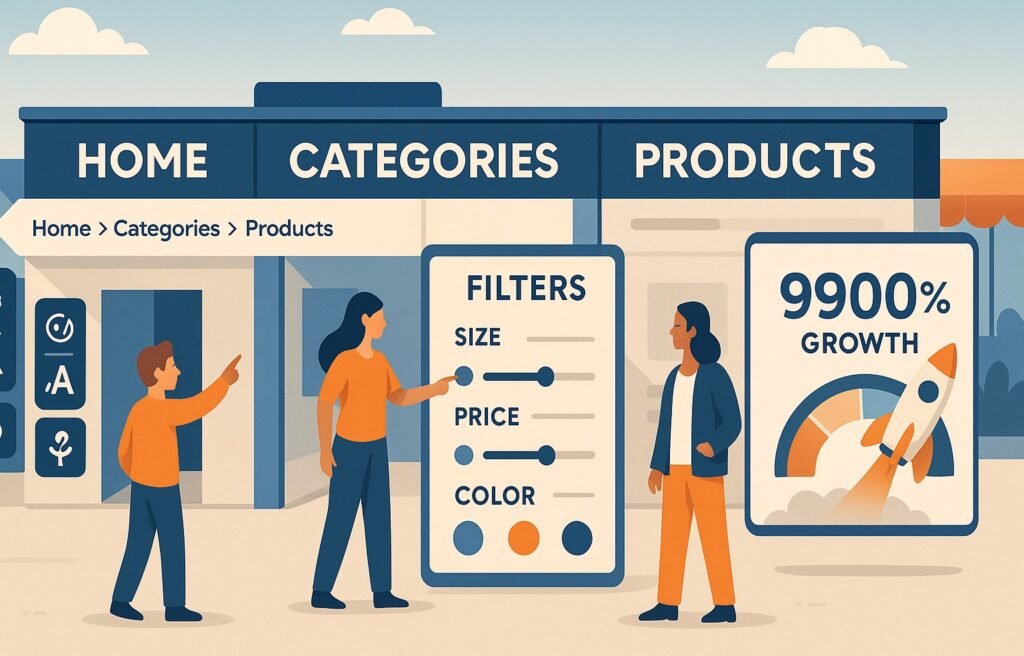
Great UX = Higher Sales
Good UX turns your market into a place people want to explore, shop, and return to. Great UX, in essence, is a revenue multiplier. It can boost your ROI by an astonishing 9,900%! That’s not a typo. That’s your website going from potato to Ferrari. UX isn’t just a pretty face; it impacts every facet of your online presence: SEO, advertising effectiveness, and most crucially, sales.
In 2025, UX is about design, architecture, efficiency, and accessibility. According to Forrester Research, every dollar invested in UX brings an average return of $100. A site that loads quickly, communicates clearly, and feels natural to use can dramatically reduce bounce rates and increase conversions.
Google recognizes this and includes page experience (measured through Core Web Vitals) in its ranking algorithm. And don’t forget accessibility: contrast, spacing, font readability, and legal standards like ADA and the European Accessibility Act matter—not only for compliance but also for SEO visibility.
Great UX Means
- Clear site architecture (Home > Categories > Products)
- Fast-loading pages (to keep people engaged with your website)
- Logical navigation (breadcrumbs FTW)
- Filters that work (well-organized filters with defined attributes allow users to quickly find what they need)
A great UX can boost your ROI by 9,900%. That’s not a typo. That’s your website going from potato to Ferrari.
Chapter 5: Technical & On-Page SEO
Imagine walking into a sprawling marketplace filled with vibrant shops, each boasting eye-catching displays and irresistible offers. But behind the scenes, there’s an intricate network of pathways, security guards, maps, and signs guiding visitors seamlessly from one stall to the next. That’s exactly what technical SEO does for your website. It’s the unseen infrastructure, the backstage crew, and the strategic blueprint that ensures your content isn’t just available—but easily discoverable, trusted, and favored by search engines.
While your users admire your flashy window displays (content and design), Google’s bots are busy reading your site’s “code-language”—the HTML, tags, and files that signal what to crawl, what to ignore, and what to showcase.

Meet the Unsung Heroes of Technical SEO:
- Robots.txt: The Gatekeeper. This humble text file acts like a bouncer at an exclusive club. It tells search engine crawlers where they can and cannot go—blocking sensitive pages or duplicate content to keep your site’s crawl budget focused on the juicy, important stuff. A misconfigured robots.txt is like accidentally locking the main entrance while leaving the back door wide open—confusing and counterproductive.
- Sitemaps: The Treasure Map. Think of your sitemap as a carefully drawn map highlighting all the key stalls in your marketplace. It tells Google exactly where your most important pages reside and how to find them quickly. Without this, search engines might wander aimlessly, missing valuable content that deserves attention.
- Canonical Tags: The Truth Tellers. Duplicate content can be a website’s worst nightmare—like having two identical shops on the same street causing customer confusion. Canonical tags gently whisper to Google, “This is the original, official page,” ensuring your site’s authority isn’t diluted across duplicates. This precision preserves your SEO juice and keeps your rankings sharp.
- Core Web Vitals: The Page Speed Hero. Google assesses your site’s “page experience” through a trio of critical metrics known as Core Web Vitals:
- LCP (Largest Contentful Paint): This measures how quickly the main visual element of your page loads – often a prominent image or a large block of text. Think of it as the speed at which your most captivating window display appears.
- INP (Interaction to Next Paint): This reflects how rapidly your site responds to a user’s very first interaction, like clicking a button. A snappy response keeps users engaged.
- CLS (Cumulative Layout Shift): This tracks the stability of your page during loading, preventing those annoying, unexpected shifts where elements jump around just as you’re about to click. Nobody likes a digital game of whack-a-mole!
If your site loads like a sloth on vacation, Google (and users) will leave.
Meta Tags & Rich Snippets

Imagine your store’s display shows your name, a catchy headline, ratings, and popular items. It grabs attention and helps both people and search engines understand what you offer.
Pages with optimized metadata can see a 30–50% improvement in click-through rates. Rich snippets (from schema markup) increase visibility and engagement by displaying additional data such as reviews, prices, and availability.
Meta titles, descriptions, canonical tags, Open Graph, and schema markup form your signaling toolkit. These elements communicate page intent, relationships, and context to search engines and social platforms. Well‑crafted tags ensure accurate indexing and help attract attention through rich, compelling previews in search results and shared links.
MetaPedia – the Wikipedia of the Meta Tags
Meta Title: The clickable title shown in search results. It’s critical for both SEO and click-through rates.
Meta Description: A brief summary of the page that appears below the meta title.
Company Rich Snippet: Enhances brand visibility by showing company info in search results.
Product Rich Snippet: Displays product details such as name, price, and availability directly in search results.
Review Rich Snippet: Adds star ratings and review data to enhance credibility and draw attention.
Canonical Tag: Signals the preferred version of a page to avoid duplicate content issues.
Open Graph Tags: Used primarily for social media platforms like Facebook or LinkedIn to control how your content appears when shared.
Chapter 6: Content Optimization
Think of content as matchmaking. Your job is to create the perfect match between what users want and what your page offers.
Some people are curious… Every section of your site serves a purpose—some explain, some compare, and some help people decide. Visitors quickly find the content that matches what they’re looking for.

Smart Content Includes:
- Clearly defined headings (H1–H6)
- FAQs, CTAs, and juicy details
- Schema markup (your rich snippet best friend)
- Unique, human-first, trustworthy writing
Oh, and don’t forget E-E-A-T:
- Experience
- Expertise
- Authoritativeness
- Trustworthiness
Google doesn’t want a random blog pretending to be WebMD. Prove you know your stuff. Share your knowledge generously, and make sure each piece of content adds real value. When you showcase expertise through clear explanations, personal insights, or original data, Google—and AI-powered tools—are more likely to recognize and cite your site as a trusted source. That’s the full package Google expects from top-performing content.
Targeted Audience: Speaking to the Right People
The right audience isn’t just anyone; it’s that specific segment of users who genuinely need your products or services, and more importantly, are eager to engage, purchase, and enthusiastically recommend you further.
Tone & Sentiment: Creating Content with Personality
Crafting content for the right people means writing relevant, insightful, and comprehensive material for your targeted audience. This involves adopting the appropriate tone and precisely matching the user’s search intent.
- Search Intent: This reflects the user’s exact purpose: are they looking to learn, discover, compare, or buy? Your page simply must meet this specific need.
- Tone: This conveys your brand’s unique personality, forging a powerful connection with visitors. Whether it’s professional, empathetic, authoritative, relaxed, technical, or inspirational, your tone should be consistent and engaging.
Page Semantic Structure: The Art of Organization
Semantic structure is where the magic happens. A clear H1–H6 heading structure and a well-placed table of contents (TOC) bring undeniable clarity to your content. Thoughtfully crafted titles, descriptions, and headings guide both your users and search engines through your content with ease. Think of your headings as the carefully organized chapters of a compelling essay: a single H1, followed by logically ordered H2s and H3s. And remember, Google reads the structure, not just the font size—so don’t rely solely on visual styling!
To truly complete the user experience, always add relevant and engaging images, compelling Call-to-Action (CTA) messages, and diverse sections, such as FAQs.

E-E-A-T: Write as an Expert
Google’s E-E-A-T principles—Experience, Expertise, Authoritativeness, and Trustworthiness—are paramount. To demonstrate these qualities, include credible sources, weave in personal experiences and expertise, and ideally, have a recognized (real human) author behind your content. In essence, be the wise sage of your niche, not just a casual observer!
Avoid Superficial Content
Content that fails to add genuine value is, quite frankly, ignored by both users and Google. Generic or redundant texts simply won’t capture attention, aren’t shared, and crucially, won’t attract those vital trust signals that are absolutely essential for a solid ranking. So, ditch the fluff and deliver the goods!
Chapter 7: AI SEO – Welcome to the Answer Engine Optimization
To earn that honor in an AI-powered world, you need to do more than write well—you need to write wisely. AI tools like Google’s Search Generative Experience, ChatGPT, and Gemini don’t browse the web like people do. They scan, synthesize, and quote. And they don’t quote just anyone. They cite sources that are clear, structured, factual, and trusted.
Imagine AI assistants start visiting your store. You post clear answers that they can quickly share with users, so more people find you.
Your job? Create content that acts like a friendly expert—fast to answer, rich in context, and easy to understand. Focus on becoming the authority AI trusts to speak for—by creating content that is clear, structured, and genuinely helpful, rather than merely chasing traffic. 🚀

How to Win in AI SEO:
- Use Answer Engine Optimization (AEO): Structure your content like Q&A.
- Be brief, be brilliant, be believable.
- Use SCQA: Situation, Complication, Question, Answer.
- Think like an AI: “Can I understand this without needing a cup of coffee first?”
Bonus Tip: Use schema, medium-tail keywords, and plain English. Avoid jargon like “synergistic bandwidth optimization” unless you’re targeting robots from 1999.
Chapter 8: Off-Page SEO
Google’s like that kid in school who only hangs out with the popular crowd. The more trusted sites that link to you, the more popular you look.
High authority score = more trust = better rankings.
Off-Page Tactics:
- Backlinks from legit sources
- Digital PR campaigns
- Influencer collaborations
- Brand mentions and link sharing on social media

Authority Score
The Online Authority Score calculates how often you’re mentioned across other websites, social platforms, and directory websites. It acts as a reputation signal—an aggregated reflection of how visible and trusted your brand is beyond your own domain.
As more blogs, news sites, and directories mention your store, your reputation grows, and more people trust and visit you.
A higher authority score often correlates with better backlink quality, more brand citations, and increased potential for ranking in competitive SERPs. Tools like Moz’s Domain Authority and Semrush’s Authority Score aggregate factors such as link strength, referring domains, and traffic performance.
Chapter 9: Local SEO
Local SEO is like placing a big, bright pin on the map saying “We’re here!” It helps local customers find you easily and reinforces trust with search engines. But more than just a listing, it’s a strategic channel for visibility in geographic search. Google uses local relevance signals—like proximity, consistency, and engagement—to determine whether your business should be in the Local Pack or buried in the noise.
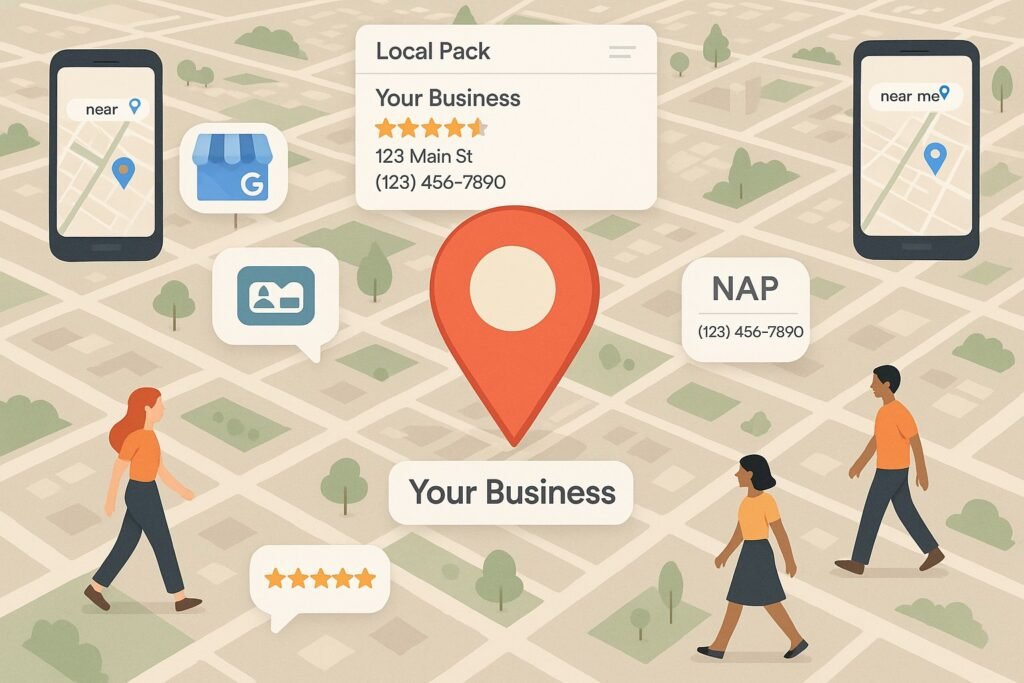
Your Google Business Profile is the digital front door of your store. It should be complete, accurate, and updated frequently with images, service listings, categories, and updates. Encourage reviews and respond to them promptly—Google takes note of business engagement.
Citations across the web must align consistently. Even a small variation in business name or phone number across directories can dilute your authority. And don’t underestimate the power of locally relevant backlinks, community mentions, or being embedded in regional content ecosystems—they reinforce that your business is part of a trusted neighborhood.
- Google Business Profile: Keep it accurate, updated weekly, and rich with media like photos, posts, and service lists.
- Consistent NAP (Name, Address, Phone): Ensure this information is identical across all directories and citations.
- Real customer reviews: Encourage authentic feedback—even the occasional tough one helps show credibility and how you respond as a brand.
Chapter 10: SEO in 2025 – The Great Digital Renaissance
In 2025, SEO isn’t just about search engines anymore. It’s about humans, machines, and the conversations between them. It’s about:
- Being the preferred answer for AI systems.
- Structuring your content for voice, visuals, and zero-click results.
- Creating a site that users love, trust, and return to.
In the end, it all comes down to one powerful equation:
Real Value + Real Expertise + Great UX + Popularity = High Rankings. 🎯

The Final SEO Checklist:
✅ Write helpful, human content
✅ Design with UX and accessibility in mind
✅ Master technical SEO basics
✅ Optimize for AI and voice search
✅ Build backlinks like a digital socialite
✅ Stay curious and keep testing
From Invisible to Irresistible
Your once-hidden store is now the star of the plaza. You’ve built the roads, put up the signs, and crafted the message. The world (and Google) is ready.
Just remember: SEO is a continuous journey of growth and improvement. It’s an ongoing love story between your site and your users. With humor, clarity, and a bit of geeky charm—you’ll not only rank, you’ll resonate.
Mastery comes with iteration. Test. Measure diligently. Refine continuously.
Now go forth, SEO wizard. May your rankings rise, your bounce rate drop, and your traffic flow like a never-ending river of opportunity.
Or at least… more than last month. 🧙♂️📈
